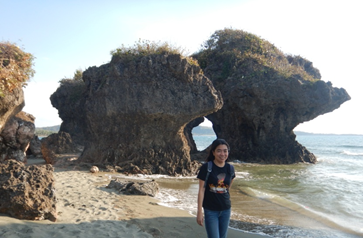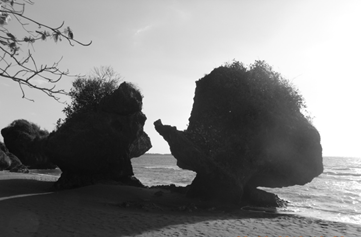The rock mushroom has been popularized by Nintendo’s Super Mario as power up items which is used to break down crystals, knock down heavy objects and roll over enemies. However, in some parts of the world such as Egypt, Israel, etc., these features are observed as naturally occurring pedestal rocks resembling mushrooms. In the Philippines, we have our own version of these structures, mostly exposed in Sitio Sabangan Norte of Barangay Boboy, Agno, Pangasinan, which fascinates tourists and nature enthusiasts. They are locally known as the “Umbrella Rocks”, resembling sprouting giant mushrooms dotting Sabangan Beach near the mouth of Balincaguing River. These amazing rock pedestals were observed by a team from the Marine Geological Survey Division during the conduct of coastal geohazard assessment survey along the beaches of Pangasinan.
The Pangasinan mushroom rocks are composed of coralline limestone, which are probably part of the carbonate deposits extensively exposed along the coastal areas of the province. The rocks are most likely ancient reef and shelf deposits which were eventually exposed to the surface by tectonic movement or fall of sea level. Overtime, through the process of weathering and actions of groundwater, the limestone have developed into karst topography with caves, sinkholes and natural pool. Prolonged exposure to agents of erosion and pounding of waves, the limestone had formed notches at the base while roofs of some caverns collapsed forming sea archs. Since Barangay Boboy is facing the West Philippine Sea and near a river system, it experienced severe pounding actions of waves particularly during typhoon and “habagat” seasons, causing undercutting and blasting effects on the rock. The wearing away of the sea arches produced isolated pillars, the so-called “sea stacks”. Long progressive lapping of waves and the corrosion of weaker parts jutting out of the water had trimmed therock pedestals, ultimately resulting into the mushroom or umbrella-like configuration seemingly defying the forces of gravity. The rate of formation of these geologic structures was so slow that it probably took thousands to millions of years constantly changing for as long as they stand.
Overall, the impression is that coastal erosion brings negative impacts to the affected area, however, it is fascinating to note that the destructive powers of waves and wind had created alluring features such as these “Umbrella/Mushroom Rocks” serving its aesthetic purpose as an ecotourism site and at the same time shielding the backshore communities of Agno against the impacts of coastal hazards.

Rock mushroom dotting the beaches of Sitio Sabangan, Barangay Boboy, Agno, Pangasinan.
By: Marine Geological Survey Division
